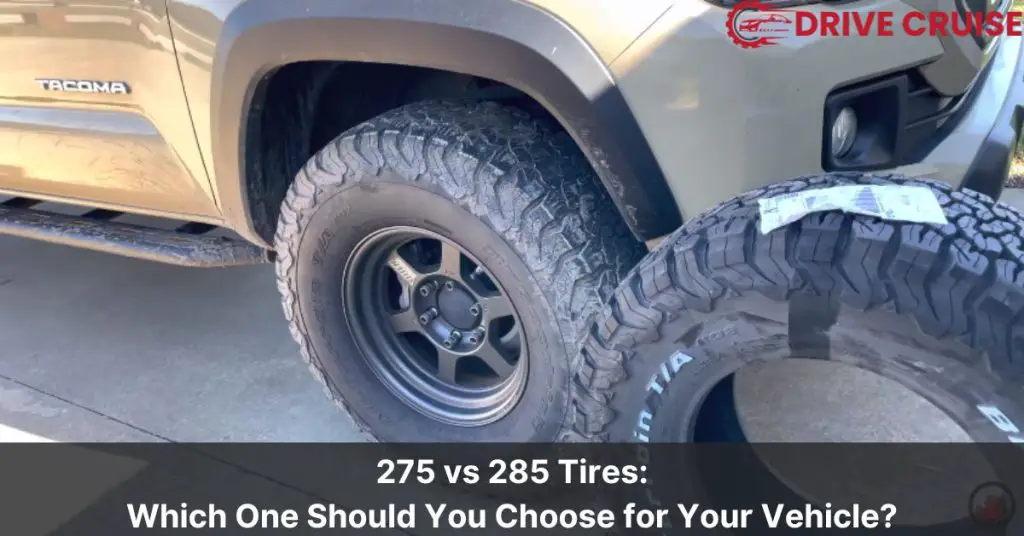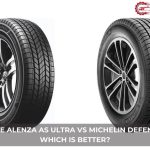When it comes to purchasing new tires for your vehicle, there are a variety of factors to consider. One of the most important is the size of the tire, which is often indicated by a series of numbers and letters on the sidewall of the tire. These designations can be confusing, but understanding them is crucial for ensuring that you select the right tire for your vehicle.
One of the most common variations in tire size is width, which is indicated by the first number in the tire designation. For example, a tire with a designation of 275/55R18 has a width of 275 millimeters. However, there are also tires with a width of 285 millimeters, and understanding the differences between these two sizes is important for optimal performance and fitment on your vehicle. In this article, we’ll explore the differences between 275 and 285 tires and help you determine which size is right for your needs.
Dissecting the Numbers: What Do 275 and 285 Represent?
Tire sizes can be confusing, with a series of numbers and letters that may seem like gibberish to the uninitiated. In this section, we will break down the different components of a tire size designation using 275/55R18 as an example.
Breakdown of Tire Sizing
- Section Width (e.g., 275): This number represents the tire’s tread width in millimeters from sidewall to sidewall. In this case, the tire’s tread width is 275 millimeters.
- Aspect Ratio (e.g., 55): This percentage indicates the tire’s sidewall height as a function of the section width. In this example, the sidewall height is 55% of the tire’s section width, which is 151.25 millimeters.
- Rim Diameter (e.g., R18): This refers to the diameter of the wheel in inches that the tire is designed to fit on. In this case, the tire is designed to fit on a wheel with an 18-inch diameter.
Now that we’ve broken down the different components of a tire size designation, let’s take a closer look at the difference between 275 and 285 tires.
The first number in a tire size (285 and 275) represents the tire’s width in millimeters. The second number refers to the aspect ratio, which is the height of the sidewall expressed as a percentage of the tire’s width. For example, a 275/55R18 tire has a tread width of 275 millimeters and a sidewall height that is 55% of that width.
The main difference between 275 and 285 tires is their width. A 285 tire is wider than a 275 tire, with a tread width that is 10 millimeters wider. This difference in width can affect the handling and performance of your vehicle.
In general, a wider tire will offer better stability and traction, making it ideal for larger vehicles like SUVs or trucks. On the other hand, a narrower tire will provide a more nimble feel, favored by sports car enthusiasts.
Impact of Width Variation: 275 vs. 285 Tires
Considering Performance Differences
When it comes to the 275 vs. 285 tire debate, the main difference lies in their width. The 285 tire is 10mm wider than the 275 tire, which can have an impact on the performance of your vehicle.
Wider Tires (285):
- Potential for Increased Grip: The wider contact patch provided by the 285 tire can enhance cornering grip and overall handling, especially for performance-oriented vehicles. This can result in improved stability and confidence while driving.
- Braking Performance Considerations: Wider tires might offer slightly improved braking performance due to the larger contact patch. However, it is important to note that this difference may not be significant and might depend on other factors such as tire compound and road conditions.
- Fuel Efficiency Impact: Wider tires can contribute to slightly lower fuel economy due to increased rolling resistance. This is because wider tires have more surface area in contact with the road, which can increase friction and resistance.
Narrower Tires (275):
- Potential Benefits for Lighter Vehicles: Narrower tires might be preferable for lighter vehicles or those prioritizing fuel efficiency due to less rolling resistance. This can result in slightly better fuel economy.
- Responsiveness and Agility: Narrower tires might offer a slightly sharper steering response and better agility, especially for smaller vehicles. This can result in a more engaging driving experience.
Fitment Considerations: Ensuring Compatibility with Your Vehicle
It is important to consult your vehicle’s manual or manufacturer specifications to determine the recommended tire size for optimal performance, safety, and clearance. Using a tire size that is significantly different from the recommended size can have negative effects on your vehicle’s performance and safety.
Potential Impact on Odometer Accuracy:
Significant deviations from the recommended tire size can affect speedometer and odometer readings. This is because the circumference of the tire affects the distance traveled per revolution.
Clearance Issues and Modifications (if applicable):
Wider tires can cause clearance issues, especially when considering factors like suspension setup and wheel offset. It is important to ensure that the tire size you choose is compatible with your vehicle’s suspension and wheel setup. In some cases, modifications may be necessary to accommodate wider tires.
Making an Informed Decision: Choosing the Right Tire Width
When it comes to choosing between 275 and 285 tires, there are several factors to consider. Both tire sizes have their own advantages and disadvantages, and the right choice depends on your driving style, vehicle type, and performance priorities. In this section, we will explore some of the key factors to help you make an informed decision.
Prioritizing Performance and Handling
If you prioritize enhanced grip, handling, and braking performance, and your vehicle can accommodate a wider tire size without clearance issues, then 285 tires might be a good option. The wider tire provides a larger contact patch with the road, which can result in better traction and cornering ability. This can be especially beneficial for high-performance vehicles or those driven in aggressive driving conditions.
Fuel Efficiency and Responsiveness
Drivers who prioritize fuel efficiency, a lighter steering feel, and responsiveness, especially in lighter vehicles, might benefit from sticking with the recommended tire size or opting for a slightly narrower option (if allowable based on manufacturer specifications). 275 tires typically have a lighter footprint on the road, resulting in less rolling resistance and improved gas mileage. Conversely, 285 tires may reduce fuel efficiency due to their broader surface area and increased weight.
Consulting a Tire Professional for Expert Advice
Choosing the right tire size can be a complex decision, and it’s important to consider all the factors involved. We recommend consulting a trusted tire professional to discuss your specific vehicle, driving style, and performance priorities. They can help you determine the optimal tire width based on your needs and ensure proper fitment to avoid any clearance or performance issues. A tire professional can also provide expert advice on tire brands, tread patterns, and other important factors to ensure you get the most out of your tires.
Conclusion: Selecting the Perfect Fit for Your Ride
When it comes to choosing between 275 and 285 tires, there are a few key considerations to keep in mind. First and foremost, the width of the tire will have an impact on your vehicle’s performance, particularly in terms of traction and handling. A wider tire like the 285 will generally provide better grip, especially in off-road or wet conditions, while a narrower tire like the 275 may be better suited for highway driving due to its smoother ride.
Another important factor to consider is fitment. Not all vehicles are designed to accommodate both 275 and 285 tires, so it’s important to consult your vehicle’s specifications and seek professional advice before making a decision. Installing the wrong tire size can lead to poor handling, increased wear and tear on your vehicle, and even safety issues.
Finally, it’s worth considering the impact on fuel efficiency. Generally speaking, wider tires like the 285 will have a slightly larger contact patch with the road, which can lead to increased rolling resistance and decreased fuel economy. However, the difference is typically small enough that it shouldn’t be a major concern for most drivers.
Related Posts:
275 vs 285 Tires: Which One Should You Choose for Your Vehicle?
How Much Is an Alignment at Big O Tires? Find Out Here











